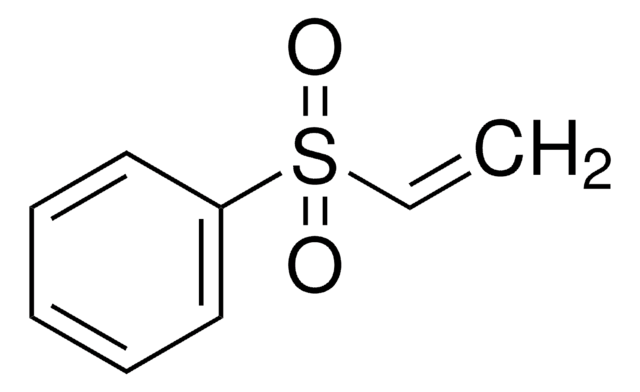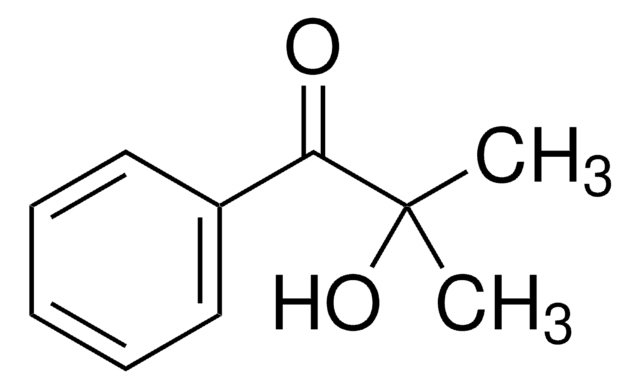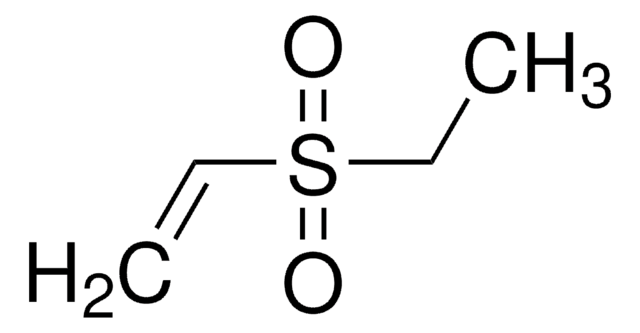340855
Glutaraldeide
50 wt. % in H2O
Sinonimo/i:
Dialdeide glutarica, Pentano-1,5-diale
About This Item
Prodotti consigliati
Densità del vapore
1.05 (vs air)
Livello qualitativo
Tensione di vapore
15 mmHg ( 20 °C)
Stato
liquid
Concentrazione
50 wt. % in H2O
tecniche
electron microscopy: suitable
immunoblotting: suitable
immunohistochemistry: suitable
Colore
colorless
Indice di rifrazione
n20/D 1.42
Punto di fusione
-21 °C ((-6 °F))
Solubilità
water: soluble
Densità
1.106 g/mL at 25 °C
Compatibilità
suitable for microfluidics/nanofluidics
applicazioni
cell analysis
genomic analysis
life science and biopharma
sample preparation
Stringa SMILE
[H]C(CCCC([H])=O)=O
InChI
1S/C5H8O2/c6-4-2-1-3-5-7/h4-5H,1-3H2
SXRSQZLOMIGNAQ-UHFFFAOYSA-N
Cerchi prodotti simili? Visita Guida al confronto tra prodotti
Descrizione generale
Glutaraldehyde is capable of efficiently crosslinking amine and hydrazine derivatives to proteins and other amine-containing polymers. Notably, in certain reactions, biotin hydrazides have been directly coupled to nucleic acids using glutaraldehyde, presenting a potential utility in conjugating fluorescent hydrazides and hydroxylamines to DNA. In histology studies, Glutaraldehyde is also employed to preserve tissue sections and prepare them for closer examination.
Applicazioni
- To compose the fixative solution (Glutaraldehyde + Paraformaldehyde + NaPO4) for use in high-resolution light microscopy and electron microscopy studies.
- To study the conjugation of goat anti-horseradish peroxidase with alkaline phosphatase by a reported method.
- To compose the primary fixative, which is employed to protect the deterioration of cytoplasmic features of yeast cells during permanganate fixation.
Caratteristiche e vantaggi
- Versatile and adaptable for wide variety of research applications
- Ready-made solution reduces the need for preparation time
Altre note
Prodotto comparabile
Avvertenze
Danger
Indicazioni di pericolo
Classi di pericolo
Acute Tox. 3 Inhalation - Acute Tox. 4 Oral - Aquatic Acute 1 - Aquatic Chronic 2 - Eye Dam. 1 - Resp. Sens. 1 - Skin Corr. 1B - Skin Sens. 1 - STOT SE 3
Organi bersaglio
Respiratory system
Rischi supp
Codice della classe di stoccaggio
6.1A - Combustible acute toxic Cat. 1 and 2 / very toxic hazardous materials
Classe di pericolosità dell'acqua (WGK)
WGK 3
Scegli una delle versioni più recenti:
Possiedi già questo prodotto?
I documenti relativi ai prodotti acquistati recentemente sono disponibili nell’Archivio dei documenti.
I clienti hanno visto anche
Il team dei nostri ricercatori vanta grande esperienza in tutte le aree della ricerca quali Life Science, scienza dei materiali, sintesi chimica, cromatografia, discipline analitiche, ecc..
Contatta l'Assistenza Tecnica.







